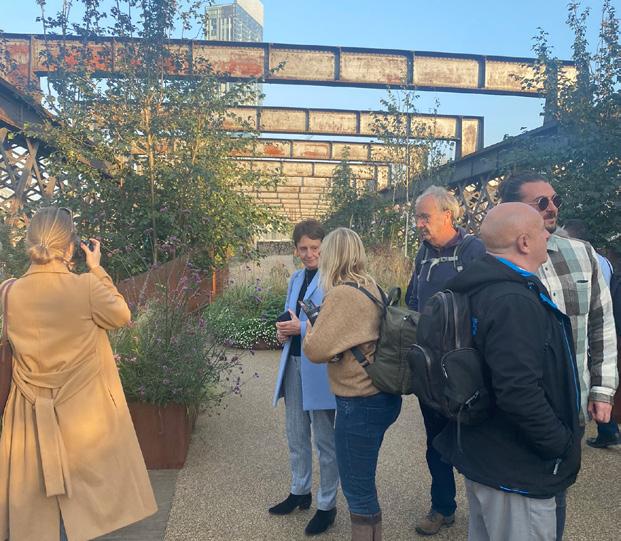
5 minute read
The impact of choosing the right materials
Clerkenwell Close Exterior © Agnese Sanvito
Materials specification is at the heart of moving towards net zero, an obligation shared between engineers and landscape architects.
Embodied carbon has become the most talked about issue in the built environment in recent years, and rightly so. However, it is often easy to overlook in the design of landscapes, whether rolling countryside estate or inner-city public realm. Often it is not considered in the same way as flood risk or sustainable drainage, meaning that landscapes can actually have high levels of embodied carbon, much of which is buried below the surface.
Unfortunately, embodied carbon makes its way into schemes in many ways, especially through materials that aren’t as low carbon as you would expect. For example, one of the most commonly specified hard landscape finishes is stone, in particular Chinese granite, which has grown in popularity in recent years as it’s attractive, hardwearing and cost effective. Stone as a raw material is of course very low in embodied carbon, but what many people don’t realise is the carbon generated from transporting it from China means that it can actually be more carbon intensive than concrete sourced and manufactured in the UK and Europe.
Stone is also problematic in terms of waste. A high proportion (50% +) of quarried material may not meet design specification (in terms of uniformity, dimensional properties, inclusions, fossils and fractures etc) and goes to waste, normally by being crushed, even though fundamentally there is nothing wrong with it. So stone is not always a low carbon option, especially if there is a lot of transport and waste involved.¹
Concrete is a material so prolific and problematic in landscape infrastructure that it really deserves its own article. Engineers exacerbate the issue as we specify concrete as if it grows on trees when, unfortunately, it is extremely high in embodied carbon. However, the majority of its carbon comes from the production of cement. If you can reduce or remove the cement through an intelligent and considered specification, then you can actually create a comparatively low carbon material. Cement replacements are readily available but are not often specified in landscape works, and there are also new concretes coming to market which use graphene and other materials to reduce the amount of cement required. An example of this is GEN3 concrete, which is typically specified in landscape applications and comes straight from the standard highways specification. It has a high minimum cement content which could be reduced to achieve a more durable product using cement replacement such as GGBS.
Changing the perceptions of our clients is key to minimising embodied carbon. Kerbs, planters, sculptures and benches formed in locally sourced stone or timber are more than durable enough and create more opportunities for biodiversity (especially when you factor in the degradation of timber).

St Alphage Garden
© Agnese Sanvito
We also need to move away from the idea that we can build something and leave it unmaintained, as this leads to the specification of inherently high embodied carbon materials such as concrete and steel. I once asked a landscape architect why they always specified steel plate for border edging, as steel is inherently high in carbon. The response was that the client doesn’t want to do any maintenance. This bemused me – if you follow the argument through to its logical conclusion, then the landscape architect should not have specified any plants either, as these would need to be watered in hot months and protected in cold months. Maintenance, alteration and repair should be part of the toolkits we use to make our designs lower carbon. This will require a change in client mindsets, but we are not far away from a time where embodied carbon will have significant financial implications that inevitably will force their hand.
Finally, we come to the circular economy. Specifying materials which can be reused or come from an existing source such as paving, kerbs and stonework is a very low carbon way of creating new landscape infrastructure. Unfortunately, it is not necessarily cheaper than specifying new products, as the labour costs involved in reclaiming, storing and relaying these materials can be quite high.
So, how can we move towards net zero with our specifications?
Source locally
Do we need to import materials from the other side of the world, where the financial success of our projects relies on either economies of scale or low paid workers to keep costs down?
Sourcing local natural materials like timber and stone will always be lower carbon than sourcing the same products from the other side of the world.
Be responsible
We need to ensure as designers that we are doing our own due diligence on embodied carbon figures quoted in product literature – you wouldn’t specify a material or product without undertaking your own due diligence on its durability or strength, so why wouldn’t this extend to embodied carbon?
Specify intelligently
Carefully consider the materials specification and whether you really need the durability, strength, tolerance and uniformity you have specified. Review the information you have been using for the last ten years. Does it align with current best practice and technologies? Are you overspecifying or are expectations on quality of finish far too high?
Specify re-used or for re-use
Specify reclaimed materials where possible, and where it isn’t, specify those that could be reclaimed in the future.

Tom Webster
A Director at Webb Yates and has extensive expertise in practical engineering design and project management, particularly in the sports and leisure sectors.
References:
1 (https://ec.europa.eu/eurostat/databrowser/view/env_wasgen/default/table?lang=en) Reference is to mineral waste.










